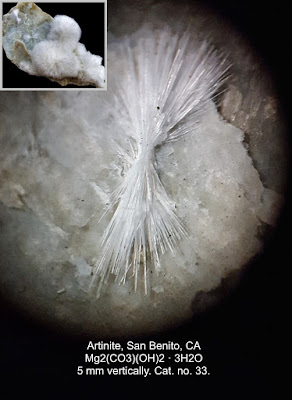The mineral is artinite, a magnesium carbonate that is an
alteration product of high-magnesium serpentinites of the Diablo Range in
central California. It’s from New Idria, a mercury (and other) mining district
named for the historic Idria mercury mines now in Slovenia, which have been
mined since 1490.
Tectonically, the New Idria area of California is in a
fenster (German for window), a hole in a thrust sheet that is related to the
collisions that produced the California Coast Ranges. Serpentine’s mechanical
properties are such that it can flow – very slowly on human scales – and in
places like Mt. Diablo and New Idria, it has risen buoyantly like a salt dome
to breach the thrust sheet and bring the underlying serpentine to the surface.
The magnesium-rich serpentinite is part of the Coast Range
Ophiolite – a word meaning “snake rock” for its often greenish color and scaly
texture. Ophiolites are usually bits of oceanic crust that have been emplaced
within or upon continental crust, and that’s what happened here.


No comments:
Post a Comment